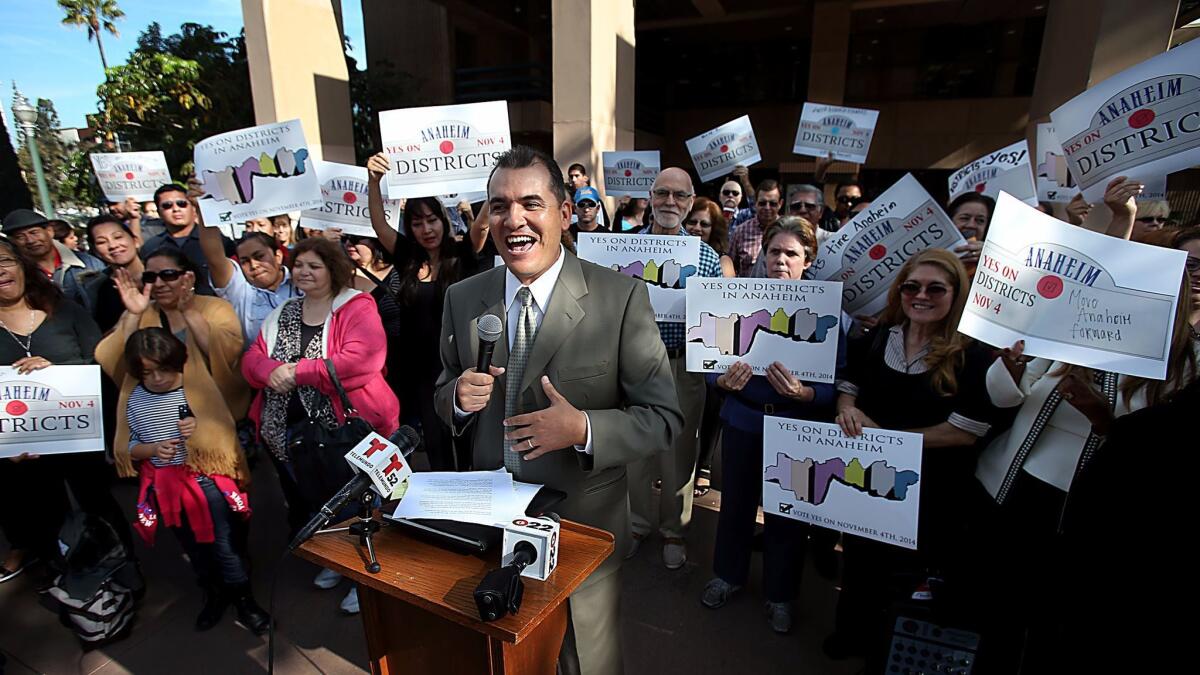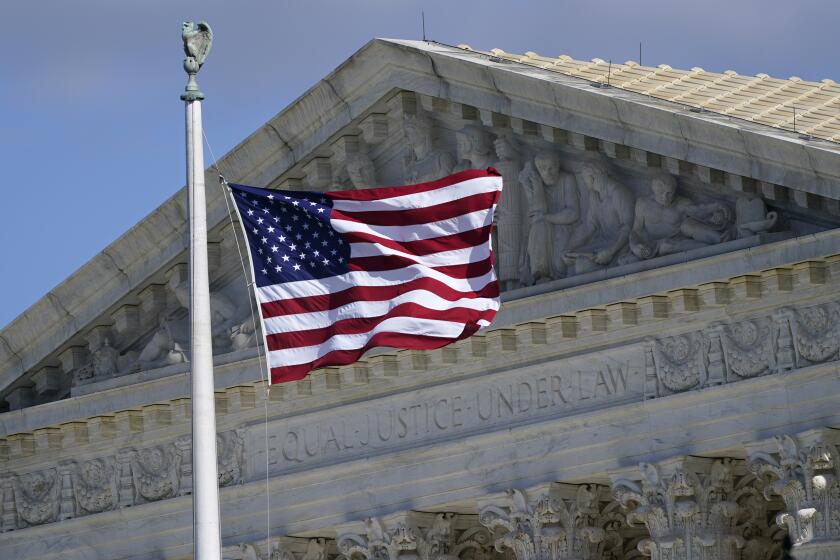A voting law meant to increase minority representation has generated many more lawsuits than seats for people of color

- Share via
Reporting from Sacramento — Two years ago, the city of Palmdale settled a lawsuit alleging that its system of electing all four council members by citywide votes was rigged against Latinos and other minorities.
In addition to a $4.5-million payout, the city agreed to scrap its “at large” voting system and create four separate council districts, including two with Latino majorities.
The result? The city had one appointed Latino council member before the rules change. It still has just one, though that member was elected.
Facing the threat of similar lawsuits under the California Voting Rights Act, several dozen cities across the state have switched from citywide elections in which all voters choose everyone on the council, to district elections in which geographically divided groups of voters each elect their own representative. And more are preparing to switch.
But those efforts have so far failed to deliver a surge of Latino political representation inside California’s city halls.
Of the 22 cities that have made the move to district elections since June, only seven saw an overall gain in Latino council members, according to an analysis by GrassrootsLab, a consulting firm that specializes in local government politics.
The results underscore the challenges Latinos face in gaining representation in local government even in communities, such as Palmdale, where they make up a majority of the population.
A number of factors likely contributed to the low numbers, including historically low turnout by Latino voters and a lack of candidates with the means to run, experts said. Also, even in cities with large Latino populations, some residents can’t vote because they are too young, are here illegally or are not citizens.
The threat of legal action has forced cities to switch to council districts, but in some cases the move hasn’t resulted in more minority representation because the city already is well-integrated and drawing districts where minorities predominate is difficult.
Among the cities that made the switch from “at large” citywide voting are the Central Valley city of Visalia, which moved to district elections last year after Latino residents filed a lawsuit. They noted that only one Latino had ever been elected to the five-member council even though Latinos account for 46% of the population.
Even after the switch, though, not a single Latino was elected to the council last November — and none even ran for the two districts that were up for grabs, according to the Grassroots study. .
“These are not encouraging results,” said Robb Korinke, who helps run GrassrootsLab and is a former Democratic Congressional Campaign Committee official.
Of course, simply changing to district elections under threat of legal action doesn’t guarantee that Latinos will be elected. For that to happen, there must voter registration, strong candidates and robust participation by the electorate.
The push to carve cities into districts started almost 15 years after the passage of the Voting Rights Act, which was intended to increase opportunities for Latinos and other minorities to elect a representative of their choice.
Advocates argued that citywide elections for all council seats can dilute the political power of voters from underrepresented groups. The law allows legal action against a local government if an attorney or resident can show an underrepresented minority has voted as a group for certain candidates, and those candidates didn’t win because voters citywide chose a different one. It applies to city councils, school districts and other government bodies with elected representatives.
California’s biggest cities — including Los Angeles, San Diego and San Francisco — held elections by district before the advent of the Voting Rights Act. But among California’s 482 cities, only 59 hold district elections, according to a report released in December by the government watchdog group California Common Cause.
Nine of those 59 had switched to district elections after the passage of the 2002 law until last year, when nearly two dozen suddenly made the change. At least 14 more are considering switching over the next two years and most of them are facing threats of a lawsuit if they don’t.
Eric Dunn, an attorney for the high desert city of Hesperia, said the main driver for Hesperia’s switch to district elections was the legal threat. No local government that holds citywide elections has ever won a California Voting Rights Act lawsuit, according to the League of California Cities.
“That’s tipped the scales for many cities,” Dunn said. “As the city attorney you’re in a position where you have to tell your client that your odds of winning are zero.”
Hesperia, which is nearly 50% Latino, currently has an all-white City Council. The city’s first district elections are not scheduled until 2018.
Dunn said, however, that Hesperia is so well-integrated it would be difficult to create a Latino council district that doesn’t resemble a Rorschach inkblot test — which would likely run afoul of federal voting rights law.
Hesperia began the process of moving to district elections after getting warning letters from two separate attorneys within a month. The first arrived in December 2015 from Malibu attorney Kevin Shenkman, the lead attorney in the successful lawsuit against Palmdale. The letter alleged Hesperia’s citywide voting system weakened the political influence of Latinos, and it advised the city to change to district elections.
Shenkman estimates that he’s filed roughly 10 Voting Rights Act lawsuits. He said he couldn’t remember how many warning letters he has sent to local governments, but this year alone he sent letters to Oceanside, San Marcos, Vista, Cathedral City and Fremont.
Some city officials complain that lawyers see the voting rights cases as a way to collect large attorneys’ fees. As Palmdale Mayor Jim Ledford put it: “I didn’t think the lawsuit was about anything except making money.”
But Shenkman countered that, saying he worked for years on the Palmdale case, where he won the $4.5-million settlement, even though he wasn’t sure he’d ever see a penny from it.
“We did very well on the Palmdale case. But people who criticized us don’t realize the enormous risk that we took,” Shenkman said.
Former state Sen. Richard Polanco, a Democrat who authored the Voting Rights Act, said the law included a provision for legal fee reimbursement in successful lawsuits because lawmakers believed it was better to have local governments pay millions in settlements than rob minority groups of fair representation.
But state lawmakers last year moved to protect cities from massive legal bills and to give them time to take steps to avoid lawsuits. The new law allows cities 135 days to switch to district elections through the ordinance process after it’s been warned it could be in violation of the Voting Rights Act. It also puts a $30,000 limit on the amount cities must reimburse attorneys or other groups that challenge their election system, so long as no lawsuit is filed against the city.
Douglas Johnson of National Demographics Corp., which has advised dozens of cities in voting rights cases, argues Latinos have made the most gains in cities where the switch to district elections was driven more by grassroots efforts than the threat of lawsuits.
“There are ... cases where a lawyer blasts out letters to 20 different jurisdictions to generate a lawsuit and make money. In those jurisdictions, there’s no candidate, no campaign organization,” Johnson said. “The most important factor … is having a good candidate who has a base of supporters and knows how to run an effective, energetic campaign. Once you have that, districts make it easier for a candidate to win.”
Thomas Saenz, head of the Mexican American Legal Defense and Educational Fund, argues that the sluggish increase in minority representatives isn’t necessarily a failure. The law was not just designed to elect minorities to local government, Saenz said, but also to increase geographical diversity on the councils and prevent one part of town, typically the wealthier neighborhoods, from having too much influence.
“Latino voters get to elect a candidate of their choice. That’s not always a Latino candidate,” Saenz said. “Maybe a non-Latino candidate is the choice of the community for whatever reason.”
Saenz’s organization has taken legal action against a handful of cities with citywide voting systems, including Bellflower and Placentia. As a result, voters in November approved ballot measures to switch to district elections. But he says his group only sues or threatens to sue when it can show that a Latino-majority district can be created in those cities.
That was the argument Jose Moreno made when he challenged the system in Anaheim. He had been trounced in a citywide run for the City Council in 2014 even though he did very well in heavily Latino neighborhoods.
Latinos make up more than half of Anaheim’s population, but they account for about 35% of eligible voters.
Latino political activists had been pushing for Anaheim to switch to district elections since the early 1990s, when the City Council rejected the idea. The switch finally came after Moreno, a former school board member, joined other Latino leaders and sued.
Last November, Moreno walked away with a victory.
“It’s about giving a community a voice,” said Moreno, chair of the Department of Chicano and Latino Studies at Cal State Long Beach.
With Moreno’s victory, the number of Latinos on the six-member Anaheim council doubled — from one to two.
Twitter: @philwillon
Updates on California politics
ALSO
Palmdale officials settle lawsuit, agree to voting by district
Plan for voting districts and publicly elected mayor wins big in Costa Mesa
In narrow election, downtown votes against creating neighborhood council for skid row
UPDATES:
8:20 p.m.: Updated to note that the previous Palmdale Latino council member was appointed and the current member was elected.
This story was originally published at 3 a.m.
More to Read
Get the L.A. Times Politics newsletter
Deeply reported insights into legislation, politics and policy from Sacramento, Washington and beyond. In your inbox three times per week.
You may occasionally receive promotional content from the Los Angeles Times.











